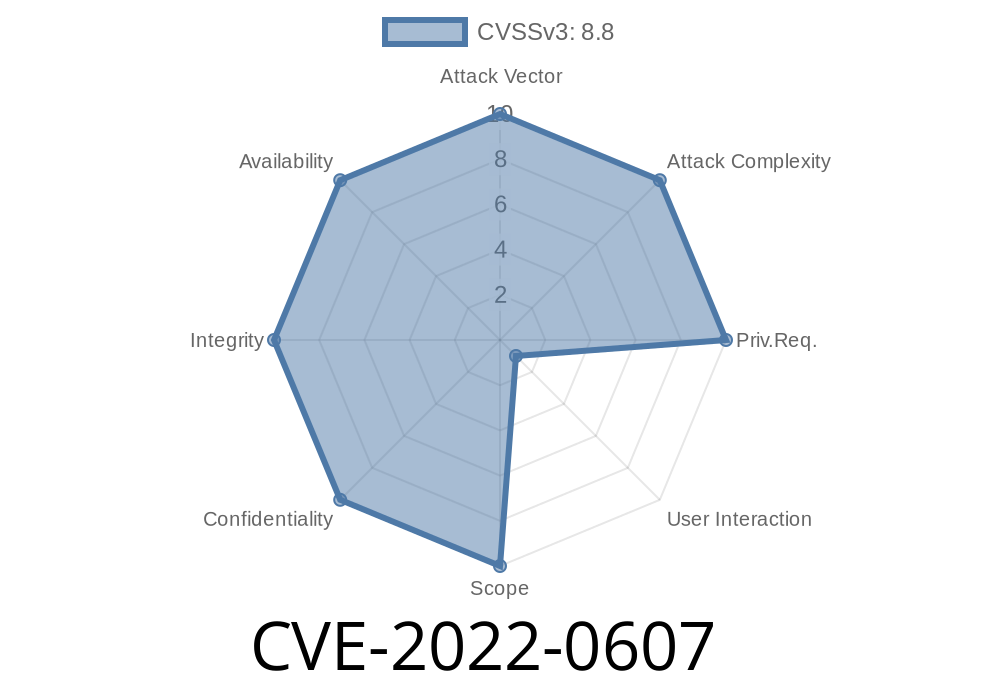CVE-2022-0607 is a recently discovered vulnerability in the Google Chrome web browser that allows a remote attacker to potentially exploit heap corruption via a crafted HTML page. This use-after-free vulnerability impacts the GPU (Graphics Processing Unit) subsystem of Google Chrome, potentially leading to unauthorized access to sensitive information or system compromise. This post aims to dissect the technical details of this critical security flaw, providing code snippets, original references, and in-depth analysis of exploitation techniques to help you understand its implications and take proactive measures.
Original References
- CVE-2022-0607 on NIST's National Vulnerability Database: https://nvd.nist.gov/vuln/detail/CVE-2022-0607
- Google's announcement of the Chrome update addressing this vulnerability: https://chromereleases.googleblog.com/2022/02/stable-channel-update-for-desktop_15.html
- Chromium Project's issue tracker (CVE-2022-0607): https://bugs.chromium.org/p/chromium/issues/detail?id=1302359
Cause of the Vulnerability
At the core of the vulnerability is a use-after-free bug in the GPU subsystem. A use-after-free error occurs when a program continues to use a pointer after its associated memory has been freed. This can lead to several potential consequences, including data exposure, code execution, or denial of service (DoS). In the case of CVE-2022-0607, the vulnerability arises due to improper handling of GPU objects in a crafted HTML page, thereby leading to heap corruption.
The following example demonstrates a simplified use-after-free scenario
#include <iostream>
class Example {
public:
void DoSomething() { std::cout << "Doing something" << std::endl; }
};
int main() {
Example* example = new Example();
example->DoSomething();
delete example;
example->DoSomething(); // Use after free
return ;
}
While this example does not replicate the specific conditions found in CVE-2022-0607, it serves as an illustration of the general concept of using a pointer after its memory has been freed. In the instance of the vulnerability, a similar usage pattern leads to heap corruption and exposes the system to potential exploitation.
Exploit Details
To exploit this vulnerability, an attacker would need to create a malicious HTML page designed to trigger the use-after-free condition within Chrome's GPU subsystem. The attacker then either has to convince the user to visit the malicious site or embed the malicious HTML code in a legitimate website through other attack vectors like cross-site scripting (XSS) or HTML injection.
Once the specially crafted HTML code is executed, the browser's GPU memory management is tricked into using the freed GPU object, resulting in heap corruption. An astute attacker can then exploit this corrupted memory state to launch other attacks such as arbitrary code execution, unauthorized access to private information, or even full system control.
Mitigations and Solutions
Fortunately, Google Chrome has already addressed this vulnerability in the 98..4758.102 version. To protect against this vulnerability and other security flaws, it's crucial to regularly update your browser and other software to the latest available versions. In addition, exercising caution while visiting unfamiliar websites and avoiding suspicious links can help protect against common attack vectors.
Conclusion
CVE-2022-0607 is a stark reminder that even the most popular and widely used software can contain critical vulnerabilities. By understanding the technical details of this use-after-free vulnerability in Chrome's GPU, we are better prepared to take appropriate precautions and mitigate the risks associated with such flaws. It's essential to stay informed about the latest security updates and follow best practices to protect our systems and sensitive information from potential threats.
Timeline
Published on: 04/05/2022 00:15:00 UTC
Last modified on: 04/11/2022 09:33:00 UTC
